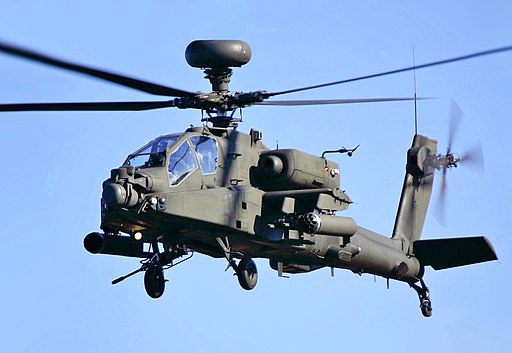In military aviation, few names carry as much weight and respect as the Apache helicopter. This fearsome machine, officially known as the AH-64 Apache, is a testament to modern engineering and a potent symbol of military might. In this article, we’ll take a deep dive into the history, specifications, and capabilities of the Apache helicopter, shedding light on why it has earned its reputation as a powerhouse in the sky.
A Brief History of the Apache Helicopter
In the 1970s, during the height of Cold War tension, the U.S. Army desired a new attack helicopter to replace their Vietnam-era AH-1 Cobra helicopter fleet. The design of the AH-64 was carried out by Hughes Helicopters, which later became part of McDonnell Douglas (and eventually Boeing).
The Apache first took to the air for its maiden voyage in 1975 and entered service in 1986, having seen action across many conflicts, such as the Gulf War, Iraqi Conflict, and Afghanistan War. Since its first appearance, its capabilities have continued to evolve, with an updated variant AH-64E Apache Guardian being introduced into service in 2011.
The Technical Specifications
The AH-64 Apache is a four-blade, twin-turboshaft attack helicopter with a tandem cockpit for a two-person crew. It features a nose-mounted sensor suite for target acquisition and night vision systems. The Apache is armed with a 30 mm M230 chain gun carried under the forward fuselage. It also has four hardpoints mounted on stub-wing pylons, typically carrying a mixture of AGM-114 Hellfire missiles and Hydra 70 rocket pods.
This helicopter is powered by two General Electric T700 turboshaft engines, each capable of producing 1,690 horsepower. The Apache is built for quick, responsive action on the battlefield, with a top speed of 182 mph (293 km/h) and a range of 476 miles (766 km).
The Role of the Apache on the Battlefield
The Apache helicopter’s primary role is as a close air support aircraft. It’s designed to track and engage targets well outside enemy range and provide accurate, rapid-fire support for ground troops.
The Apache’s advanced sensor systems and integrated electronics enable it to locate, track, and engage targets in all weather conditions, day or night. Its ability to operate at low altitudes and to ‘hover out of sight’ makes it an unparalleled platform for reconnaissance and ambush scenarios.
The Apache’s robust armor and redundant systems also make it capable of withstanding significant damage. Its advanced flight controls and handling characteristics allow it to perform nimble maneuvers, making it an elusive target.
The Apache’s Legacy
The Apache helicopter’s impact on modern warfare cannot be understated; its capabilities have revolutionized close air support and become a symbol of American military might. Combining speed, firepower, and versatility into one valuable battlefield asset makes the Apache an indispensable weapon – earning itself an unrivaled reputation among military operations worldwide as one of the world’s premier aircraft.
The Apache helicopter stands as an impressive testament to innovation and engineering, both historically and technologically. Its history, technical prowess, and battlefield performance remain unparalleled, earning it an esteemed place in military aviation history. Peace or war, it remains ever vigilant and ready to defend and protect.
What is the deadliest helicopter in the world?
As of 2023, the Kamov Ka-52 attack helicopter is considered one of the deadliest. While opinions on its culpability differ significantly between experts and non-experts, its case can easily be made. While its top speed may be 30 mph slower than the Apache’s 195 mph top speed, its operational range of 683 miles is more than double that of the Apache. Well-armored with powerful missiles capable of inflicting serious damage, it even comes equipped with anti-ship missiles to engage maritime battlegrounds.
For more insights into the Apache Helicopter and other important military aircraft, visit Aces In Action. Here, you’ll find an amazing piece of artwork by Craig Tinder titled “Apache Longbow on Patrol,” that illustrates the venerable AH-64 Apache Longbow Gunship – an aircraft that serves more than 15 countries and has accumulated over one million flight hours. The limited edition canvas print even includes a piece of aluminum from an AH-64D Apache Longbow Attack Helicopter, making it a unique piece of history!
Apache Longbow On Patrol – AH-64 Apache Longbow Aviation Art Print by Artist Craig Tinder
Entering service in the early 1980s, the AH-64 Apache was developed as a replacement for the AH-1 Cobra attack helicopter program. Commanded by a crew of two, who are both capable of flying the aircraft, the Apache can fight in close and densely-covered environments where other aircraft cannot. Equipped with a 30mm Chain Gun that is directed by the head movements of the crew, the Apache typically carries a combination of Hellfire anti-tank missiles and 70mm rockets. With over one million flight hours in combat, more than 15 countries have adopted the Apache as their primary attack helicopter.





Share:
From Tragedy to Triumph: The Legacy of the Titanic and Advances in Maritime Safety
Soaring Through History: A Look at the TBM Avenger